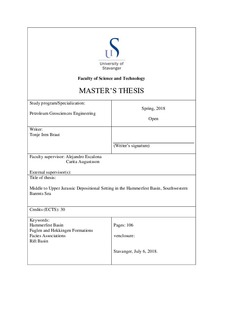| dc.contributor.advisor | Augustsson, Carita | |
| dc.contributor.advisor | Escalona, Alejandro | |
| dc.contributor.author | Braut, Tonje Iren | |
| dc.date.accessioned | 2018-11-02T09:28:05Z | |
| dc.date.available | 2018-11-02T09:28:05Z | |
| dc.date.issued | 2018-07-06 | |
| dc.identifier.uri | http://hdl.handle.net/11250/2570729 | |
| dc.description | Master's thesis in Petroleum Geosciences Engineering | nb_NO |
| dc.description.abstract | The Middle to Upper Jurassic Fuglen and Hekkingen formations of the southwestern Barents Sea represents both important source rocks and seals in several petroleum plays in the region. The current understanding of this time interval is that deposition occurred during a time of regional transgression and active rifting, in an oxic to restricted marine setting. The depositional setting and controls of deposition in the Middle to Upper Jurassic is still poorly understood, as few studies have evaluated this time interval from the basin evolution point of view. Throughout the Hammerfest Basin, the Fuglen and Hekkingen formations display great variability, both in facies and distribution. This study aims to improve the understanding of the depositional setting, the palaeogeography and the controlling factors on the lateral and vertical variabilities of the Middle to Upper Jurassic interval in the Hammerfest Basin. This is achieved by utilizing and integrating an extensive dataset comprising core data, 2D and 3D reflection seismic, and petrophysical data. Main findings includes five different facies associations, where shallow marine, restricted anoxic and mass flow deposits dominate. A time significant sequence stratigraphic framework is defined, comprising the sequences J1-J5, that are bound by regional unconformities and flooding surfaces. The sequences provides a good correlation with the existing lithostratigraphic framework, and the facies associations defined in this study. Local tectonic activity acts as the main control on the deposition of the sequences J1-J5. Diachronous fault activity led to the formation of local isolated depocenters, where the accommodation creation was controlled by differential subsidence along the different fault segments. Areas of erosion or non-deposition were present over structural high, however, clastic sediment sources were not emergent until the deposition of sequences J4-J5. The deposition of the sequences correlates with a regional sea-level rise, where the transgressional processes observed in the study area were most likely further amplified by local tectonics. | nb_NO |
| dc.language.iso | eng | nb_NO |
| dc.publisher | University of Stavanger, Norway | nb_NO |
| dc.relation.ispartofseries | Masteroppgave/UIS-TN-IER/2018; | |
| dc.subject | petroleumsgeologi | nb_NO |
| dc.subject | Hammerfest Basin | nb_NO |
| dc.subject | Facies Associations | nb_NO |
| dc.subject | Barents Sea | nb_NO |
| dc.title | Middle to Upper Jurassic Depositional Setting in the Hammerfest Basin, Southwestern Barents Sea | nb_NO |
| dc.type | Master thesis | nb_NO |
| dc.subject.nsi | VDP::Teknologi: 500::Berg‑ og petroleumsfag: 510::Geoteknikk: 513 | nb_NO |
| dc.subject.nsi | VDP::Matematikk og Naturvitenskap: 400::Geofag: 450::Petroleumsgeologi og -geofysikk: 464 | nb_NO |
